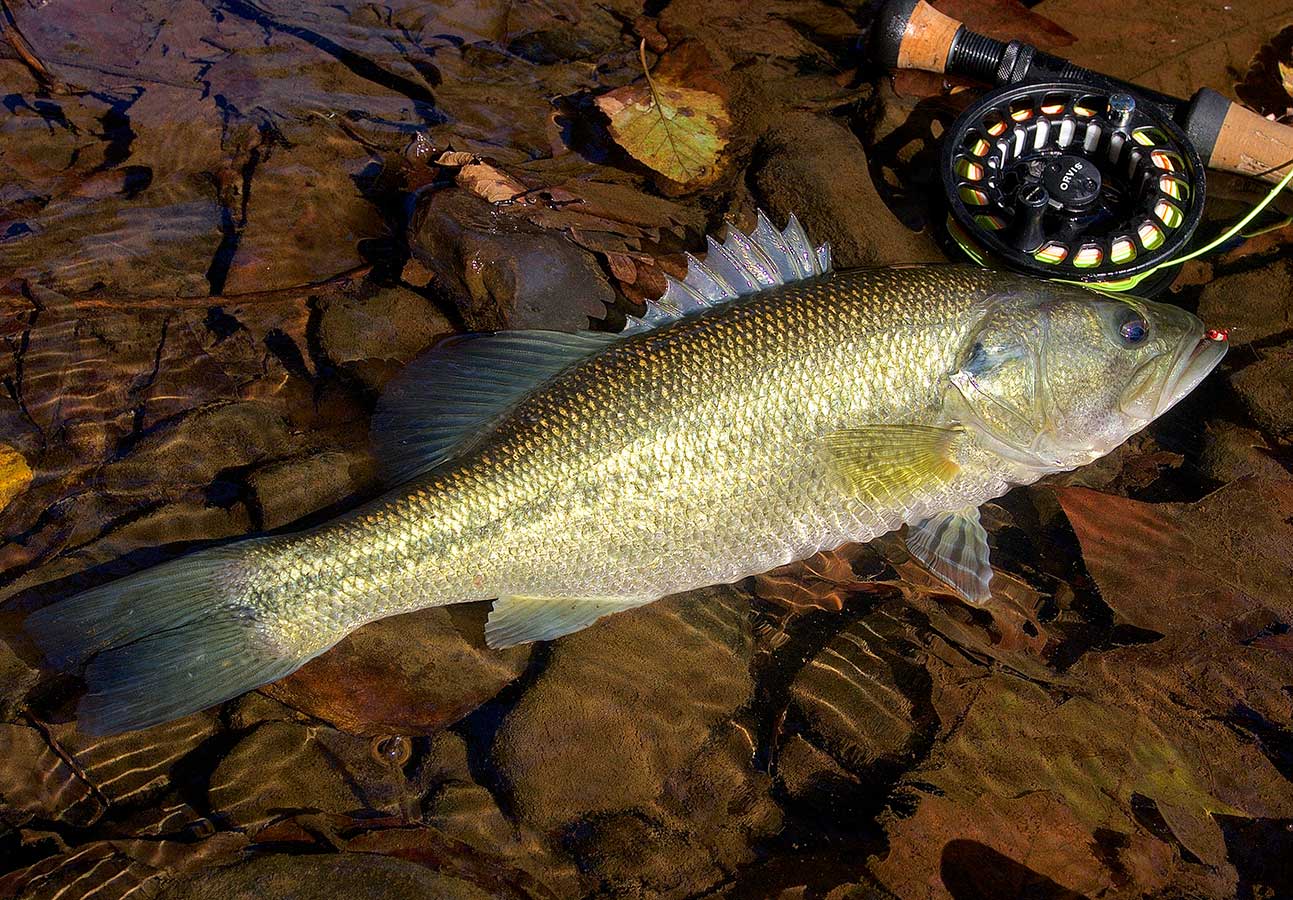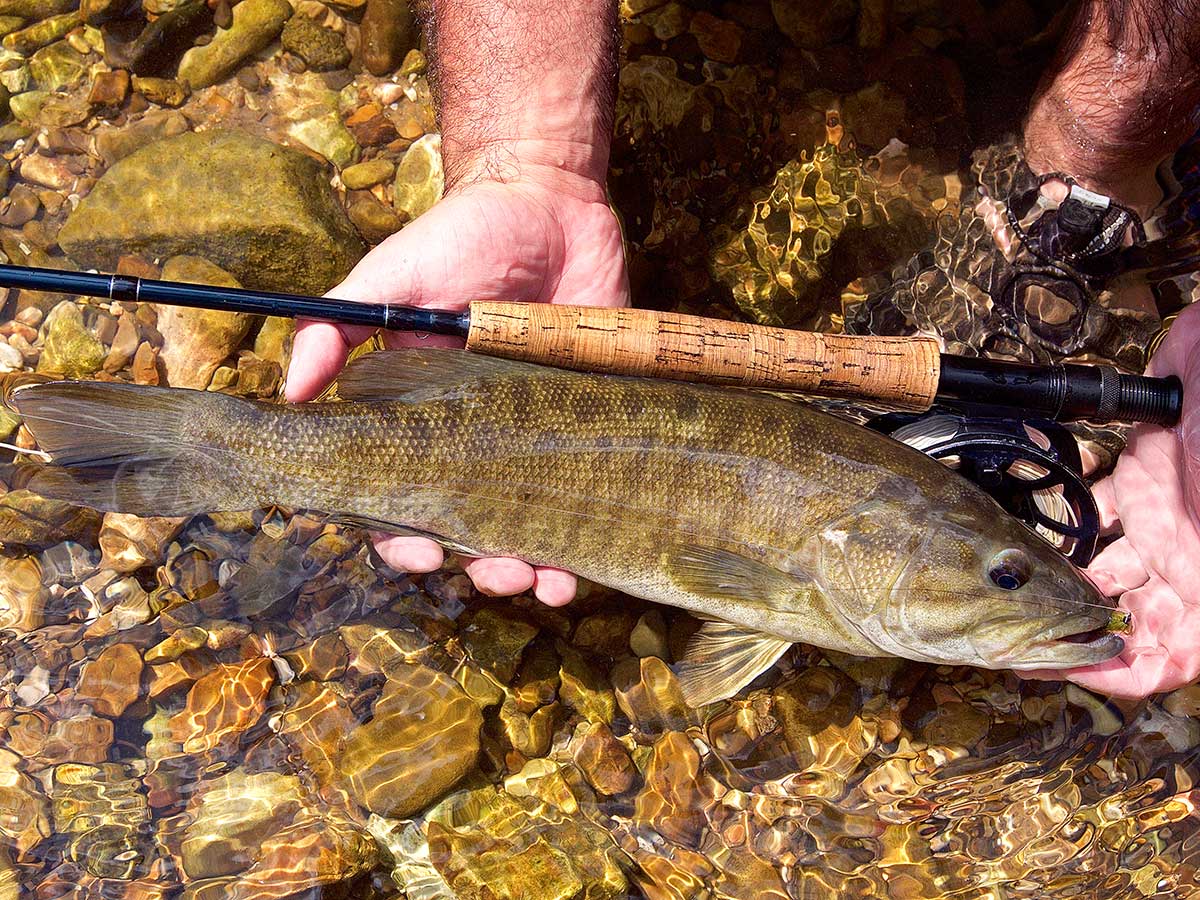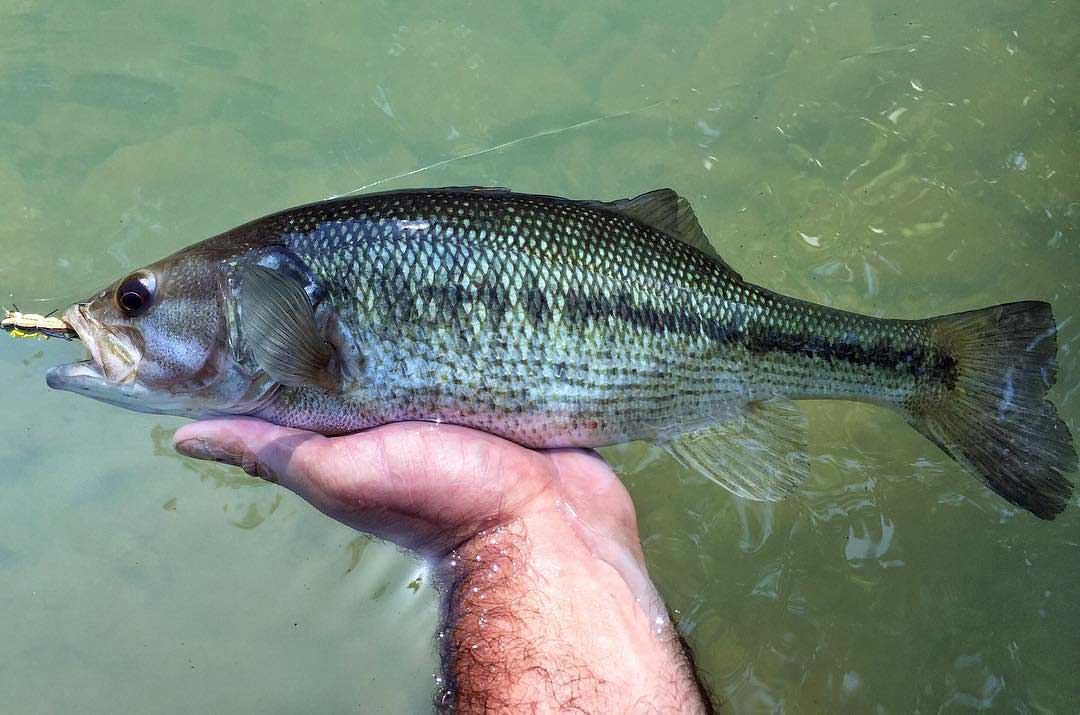Bigs, Smalls, Spots: Fly Fishing for Three Kinds of Bass

Largemouth bass
The 6-weight labors a bit, but with two false casts the heavy-headed line shoots forward, plopping the big blue popper about seven feet beyond a twig poking through the water’s surface. I wait for the ripples to settle then try to impart the spirit of a cicada with a series of short, soft strips. The popper gently gurgles in a straight line until it nudges the twig.
I know there’s a big bass of some species hiding in the tangled treetops out of sight but underneath that lone sprig of hardwood. Last week, from this very spot, I pulled in a 16-inch spotted bass with a nearly identical cast and retrieve that never made it to the twig, and earlier in the summer a 15-inch smallmouth had blasted the popper as it hit the water.
I twitch the popper away from the twig and wait a full 30 seconds before yanking the line hard, resulting in a tremendous bubbling burp. And then the popper just disappears. It takes a few moments to process what’s happened, but I finally shake the cobwebs and set the hook on something with more heft than expected given the gentle take.
A largemouth bass roars airborne, belly-flops down and bulls back toward the twig. I can feel the full complement of power; the fish’s size alone makes pulling it away from the tangles a chore. But, as largemouths are prone to do, the bass loses steam quickly. They just don’t have the stamina so characteristic of their smallmouth and spotted cousins. A few more head shakes, two short runs, and I’m cradling the 18-inch fish.
Sizable representatives of the three black bass species native to this creek all caught from the exact same cover is a rarity. In fact, I don’t know of another location where I can pull off this trifecta. But I do know how and where to catch each individual species based on cover, structure, current, and fly options from mid-spring through early autumn.
Rods, Reels and Flies for Bass
For all of my creek bassin’, I use either a 9-foot medium action 6-weight rod or a 7-foot-11-inch faster-action 7-weight. My reels are spooled with Orvis Hydros Bass/ Warmwater in the corresponding rod weight. The longer 6-weight is my preferred rod when overhead casting area and the water is more open. The 7-weight is for tighter quarters and offers more backbone to muscle bigger flies and bigger fish from brushier hideouts.
Fly sizes vary from 4 to 2/0 with my most used flies for all three species wrapped around a number 2 hook. I tie my flies to 2x, 1x or 0x (depending on conditions) tippet directly connected to line with a perfection loop. No leaders and no merit-badge leader knots required for three reasons:
- Dainty presentations aren’t required for bass. They don’t care. Sure, sometimes a soft touch is the ticket in moonshine-clear waters, but “soft” is a relative term and a fancy tapered leader won’t help when a size 4 is your “small” bugger.
- Straight tippet actually does a better job of turning those big flies. I don’t understand the physics involved, but like so many other truths in this world, my ignorance doesn’t change the facts.
- Big hooks require more energy for penetration. Big tippet tied straight to the line ensures you’ve got plenty of guts to withstand an eye-crossing hookset when a bass of whatever species thumps your fly.
Largemouth Bass (Micropterus salmoides)
Largemouth bass were my first fishing love long before I picked up a fly rod. I’ve been chucking plastic worms and crankbaits for bucketmouths since I was seven years old, even joining a bass club at age 14. As a kid, I could find largemouths in every farm pond within a five mile radius of my home. Thankfully, they’re also found in every creek I fish and are usually the biggest black bass in any body of water.
Characterized by a big head and outsized maw that when closed extends behind the eye, creek largemouth also have a longer, lankier build when compared to smallmouth and spotted bass. Featuring light green sides darkening toward the dorsal area with cream colored bellies, clear-water largemouth often display more defined markings than largemouth caught from dingier lakes and ponds. A key identifying characteristic for largemouth is a deep notch separating the spiny and soft dorsal fins.
Of the three black bass, largemouth are the toughest to fool and quickest to tire in a fight. I think both of these characteristics are a result of how they relate to current. Typical largemouth water offers the bass ample viewing time of your offering and living a more sedentary life leads to a lack of stamina… something I know from personal experience. They also generally take flies with less ferocity than their two cousins. Like the opening scene from this article, I’m often shocked at the size of the fish after a surprisingly delicate strike.
Where to Find Them
Look for the slack water and that’s where you’ll find largemouths. I’ve never caught one near a riffle or in any current to speak of. All three species frequent deep water, but I rarely find largemouths in the shallows. No matter the weather conditions — cloudy, rainy, sunny or breezy — I consistently catch largemouths in deeper water than smallmouths or spots. Steep banks lined with American water willow (the grass that seems to grow in every creek east of the Rockies), downed trees, log jams, and especially underwater woody cover are prime holds for largemouths.
The best numbers of largemouth are often found in the lower two-thirds of the creeks I fish. They don’t care for steep changes in elevation or the accompanying current.
What to Throw
Big is the key word for largemouth flies. Big Clouser minnows, big poppers, big hoppers, and big surface streamers are my go-tos. Largemouth eat any and everything, but surprisingly, I’ve not had much luck with buggers or other crayfish-imitating patterns. I think it’s because most crayfish in the creeks I frequent are found near rocks, and that’s not were I find the largemouths.
Day in and day out, the Clouser’s in a variety of weights are the fly of preference with the caveat of cicada-imitating poppers from mid-July through September. My biggest bass on the fly — a 20-inch largemouth — came on a September afternoon after she finned beneath a blue and chartreuse popper for at least a full second before gently plucking it from the surface. I also fish hollow flies tied on 2/0 circle hooks as dual-purpose largemouth/gar enticers, and they’ve paid off on bass when larger baitfish are present.
When fat largemouths suspiciously eye and never commit, my secret weapon is bunny fur. A six-inch strip of bunny tied on a 1/0 hook and led by a dumbbell weight looks and acts an awful lot like the number one largemouth lure of all time — the plastic worm. Bonus: as such, it appeals greatly to my redneck fishing roots.

Smallmouth bass
Smallmouth Bass (Micropterus dolemieu)
Probably due to my warm water angling heritage, I think of smallmouth bass as the perfect fly fishing target, and around my neck of the woods they’re known as a “cold-water” species.
Smallmouth are easy to identify. As the name implies, they have a relatively smaller mouth with the jawline never extending past the eye. They are of olive, brown or bronze coloration — sometimes solid, sometimes with dark vertical stripes. A key identifier is a near-continuation of the dorsal fin from spiny to soft rays.
Nothing in the creek pulls like a smallmouth and their tenacity is the stuff of legend — they don’t quit. Smallmouth bass are the piscine embodiment of a creek’s wildness and ferocity.
Where to Find Them
Of the three, smallmouth prefer swifter, cooler waters. My local smallmouth are the native Neosho subspecies and are the only black bass I find in upland headwaters. They populate the creeks through elevation drops until the topography flattens and the currents slow and are rarely found in area lakes or bigger rivers. Your local smallmouth may be less picky.
Early mornings, late evenings and cloudy days often produce fantastic smallmouth action in riffles and shallow runs. I’ve caught some dandies in water that barely covered their backs. Sunlight typically sends most fish to deeper water. Low-light riffle fish tend to be more aggressive as well. Their food is always on the move and they often hammer anything coming down the pike, while pool dwellers — especially bigger fish — need to be persuaded.
Smallmouth don’t hang out right in the current, but are often no more than a tail flick away.
In the shallows, look for rocks and boulders that break current and expect smallmouth to be lurking beside, underneath and sometimes in front of the obstruction. They are almost always in the sliver of slack water behind. In pools, look for smallmouth near boulders, rock piles and bluff edges. The absolute best places to catch smallmouth are where riffles empty into or drain from a pool. If there’s a steeper drop and any kind of waterfall, you can bet smallmouth will be stationed on either side and often behind the falls waiting on the current to bring a meal.
Rocks are smallmouths’ favorite orientation, but I also catch several patrolling stands of American water willow. Besides the twig and hidden woody cover mentioned earlier, I rarely catch smallmouth holding on wood in my local waters. But on a trip to Missouri streams last summer, root wads and big logs were the ticket. I watched one local angler pull a 17-inch smallmouth from a log jam
What to Throw
Aggressive, though, sometimes finicky but never too picky, smallmouth feed on crayfish, smaller fish and any terrestrial they can catch. Most smallmouth I hook fall to my own interpretations of Clouser minnows and wooly buggers. I tie the Clousers with squirrel tail (gray and fox). Squirrel tail hair is less brittle than bucktail, and the natural mottled colors look right at home in the creek.
My woolly bugger is no different from any other bugger recipe other than using the widest hackle I can find and quite a bit of marabou on a size-2 long-shank nymph hook. I like my buggers to be bulky crayfish imitators, and the wide hackle gives the appearance of bulk without adding a lot of weight. Big marabou feathers, sometimes two, add bulk on the back end and in the water resemble claws. I tie them in olive or a combination of olive and brown. Poppers and big hopper imitations round out my usual lineup with poppers getting the nod above everything else for mid-summer to early autumn, and especially in the afternoons.

Spotted bass
Spotted Bass (Micropterus punctulatus)
Spotted bass were the “other bass” when I was growing up. In color and markings, they resemble largemouth, though, typically spotted bass look more like a football with a decidedly smaller head and smaller jaw that does not extend beyond the eye. They have distinct diamond-shaped lateral line markings and rows of black-spotted scales under the lateral line, hence the name, on a light aquamarine base. Spotted bass also have a rough “tooth patch” on their tongue and a gentle dip between the spiny and soft dorsal fins.
Spotted bass are found throughout most of the creek systems I fish expect for the very start of headwaters in rugged topography. Often, they slide into smallmouth habitat as the land flattens beyond a smallmouth’s liking.
Spirited fighters, spotted bass are only slightly less ferocious than smallmouth and they typically pull longer and harder than a largemouth. Some of my most memorable fish on a fly rod have been spunky spotted bass blowing up a topwater and then barreling toward the nearest root wad.
Where to Find Them
I’ve caught spotted bass in suspected largemouth as well as smallmouth lairs and everywhere in between. Don’t be surprised to catch a spot on any piece of cover that looks “bassy.” I generally find them in gentler currents and more woody sanctuary than smallmouths, though I’ve pulled a few spots from rocks in the riffles thinking for sure I’d hooked into a brown bass until I saw the green flash and bold horizontal markings. I fish a couple of creeks in flatter country that don’t have smallmouth bass and spotted bass fill every slot I’d expect to catch a smallmouth in other waters. If I were targeting only spotted bass on a creek with all three species, I’d concentrate on banks with overhanging branches and tree roots extending into the water.
What to Throw
Topwaters rule for spotted bass in creeks during the warmer months. I’ve caught more spotted bass on poppers and hoppers than all other flies combined, and even when I thought it was too early in the year for topwaters On a late April wade last year, I cast four different Clousers, three different buggers, bunny strips, a variety of weightless streamers — even a spoon — over the course of three hours with only four fish to show. Then I tied on a size 2 black popper and caught five spots in eight casts. Second choice flies for spotted bass are Clouser minnows tied with white bucktail bellies and black or brown bucktail tops. Your third choice should circle back around to a popper.
Who Cares What Kind of Bass It Is?
Knowing what species of bass you’ve hooked and why may not rate high on the list of reasons you’re on the creek. But knowing the differences can offer a deeper understanding of micro-habitats which will lead to catching more fish. Take this simple outline for catching three black bass species during the wet-wade season and fine tune it on your local waters.
And when in doubt about which species is where and what they want to eat, throw fat poppers. A big meaty morsel struggling on the surface is irresistible to any species of black bass in the creek.











